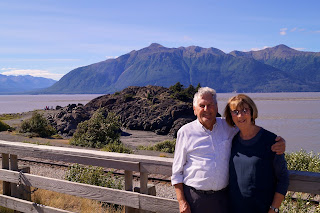Anchorage in the Cook Inlet is a dream destination with so much to offer in the way of wildlife, national parks, and as many as 60 glaciers a short drive away. There are over 100,000 glaciers in the whole of Alaska.
On our first day in Anchorage we took a tour to Mt Alyeska and on the way we stopped at Beluga Point named for the reason that on full tide the Beluga whales come into the inlet to feed. We were not lucky enough to see any that day. It is this area where they get the Bore tides which is a huge wave or a series of waves that advance down through the shallow inlet of Turnagain Arm. They are most spectacular and biggest around full moon. We could see how treacherous the water was when we were there. When the tide is out it is very thick mud with big waves of undulating mud and is very dangerous with many deaths over the years mainly fishermen and those silly enough to think they can walk out on to it.
Turnagain Arm.
In Girwood national park we took the aerial tram from the town up to Mt Alyeska where we could see 7 glaciers from the top.
The view at the top was spectacular.
There were many walking and cycle-ing trails at the top and bottom photo. During the winter it turns into a very popular ski field.
After we left Girwood we stopped many times along the way to view other glaciers. The pink flowers in the foreground are the Fire-weed. They make a beautiful display in the wild countryside.
At Portage Valley we boarded a flat bottom boat for an hours cruise on the lake to view the Portage glacier the largest of three in the area.
The boat we were on was designed for close up access to the glacier.
Back in Anchorage we had some four legged visitors to feet us on the wharf. These Alaskan huskies are used in Dog mushing races. They form a pack of 8 which pull a sled with a driver who is called a musher. I was intrigued by the icy blue colour of this dogs eyes.
The Visitors information centre in Anchorage was a delightful sod roofed log cabin. The flowers were large and extremely bright due to the long summer daylight hours.
I took this photo from the bus, of a park that had sunk during the devastating 1964 earthquake which was recored at 9.2. This part of the ground in this area dropped 15 feet which is why the bottom half of the trees are well below the road level. It was a very devastating earthquake for the city and there are still many areas that show the evidence today.
This river was near the Port where the Ship was docked. At low tide it became thick rippled mud. The port is very shallow and has to be dredged regularly to remove the mud. Anchorage get huge tidal ranges which sometimes can reach 12.2 metres. At the time I took this photo the tide was on its way in and there were only a few fishermen fishing for salmon but the day before when we crossed over there were dozens of them shoulder to shoulder for about 2-3 hundred metres along the sides.



















No comments:
Post a Comment